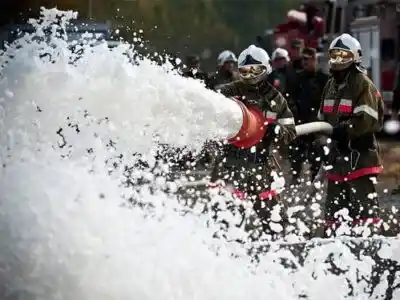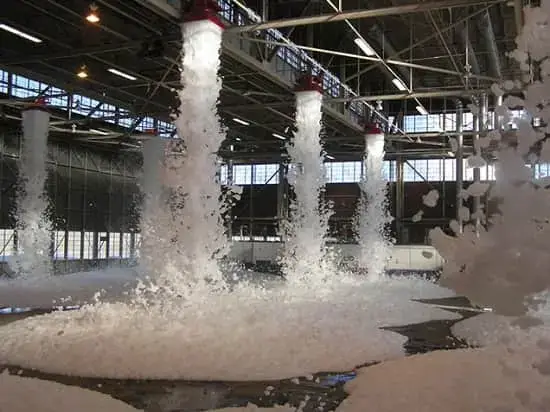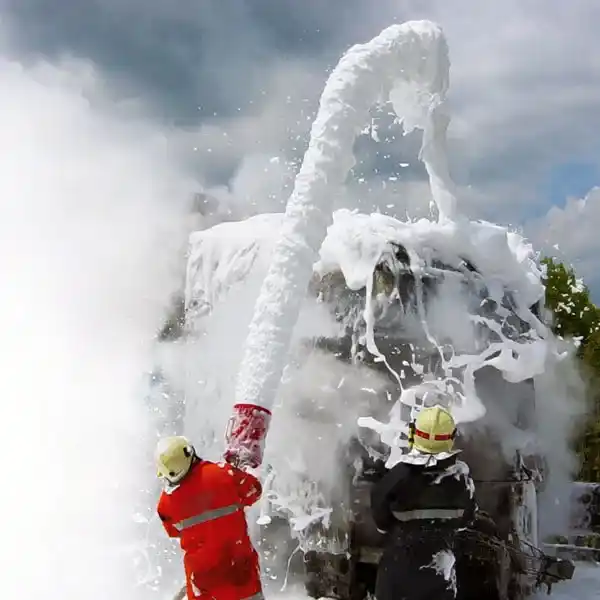Firefighting foam is a collection of small, compact and stable bubbles that have a lower density than hydrocarbon compounds. These bubbles float on most hydrocarbons and non-polar solvents and extinguish the fire by covering the surface of the burning liquid. Foam bubbles in firefighting foams are composed of water, foam concentrate and air, and when these three materials are mixed in the right proportion, a homogeneous coating of sticky and resistant bubbles is formed.
Foam solution or premixed solution is a suitable combination of water and foam concentrate in a proportion of 3%, which means that 3 parts of foam concentrate are added to 97 parts of water to obtain 100 parts of foam solution.
In extinguishing fires caused by the ignition of crude oil and its derivatives, firefighting foams are one of the most effective and efficient fire extinguishing materials that are effective in reducing the damages of huge oil fires. Unfortunately, some fluorocarbon compounds in firefighting foams, especially AFFF foams, have turned them into very dangerous chemicals for firefighters and polluting the environment. For this reason, in different parts of the world, the use of these materials has been banned or restricted, and efforts to replace them with environmentally friendly categories continue.
Firefighting foam has been used as an effective material in extinguishing oil fires for many years. Unlike other extinguishing agents such as water, dry chemical powders, CO2, etc., a stable aqueous foam can effectively extinguish the fire caused by the ignition of hydrocarbon materials by cooling and isolating the flame source, and finally suffocating the fire. If water is used as an extinguishing agent on hydrocarbons, due to the weight of water relative to hydrocarbons, the water will sink to the bottom of the hydrocarbon and will have little effect on extinguishing or covering the vapor. If the temperature of the fuel reaches above 100 degrees Celsius and in this case water is used as an extinguishing agent, the water boils under the surface of the fuel and is thrown around (boil over phenomenon), which actually makes the fuel extinguishing process out of control and Spreads the fire. For this reason, foam remains the primary fire extinguishing agent for all hazards arising from the ignition of hydrocarbons, where they are transported, processed, stored or used as an energy source.
In general, firefighting foam is used in foam fire extinguishing systems such as water monitors and firefighting foam which are combined by foam and water dosing foam system.

Fire fighting foams are generally produced from materials such as water, various solvents, chemical foaming compounds, pigments and other materials. Below are some of these materials:
1. Diluents: The main ingredient in diluting foam is water.
2. Solvents: Different types of solvents are used in the production of fire fighting foams. The largest amount of solvents is usually used in the production of chemical foams, especially AFFF firefighting foam. AFFF foams usually use a high percentage of glycol ether compounds, which are environmentally destructive solvents. These chemical solvents may harm the health of firefighters and body contact should be avoided.
3. Surface active substances: Surfactants or surface active substances are other chemical substances that are widely used in fire fighting foams. These compounds are the basic and main bubbling material in chemical foams, especially AFFF foam. AFFF firefighting foams usually contain large amounts of chemical surfactants.
4. Hydrolyzed proteins: protein compounds are very important materials in firefighting foams. These compounds, which are obtained from the hydrolysis of plant seeds or animal compounds, are used as the first natural foaming agents in firefighting foams. The hydrolysis of plant seeds and animal materials creates a foaming substance with tiny bubbles and heat resistance, which actually plays the role of chemical surfactants in AFFF foams against fire. These substances, under the name of protein, are completely environmentally compatible and do not cause any toxicity or harm to firefighters. Also, these materials have better stability and resistance than chemical surfactants in AFFF foams. Accordingly, according to international standards, FP and FFFP protein foams must have a minimum resistance to heat and fire return of at least 15 minutes, while for AFFF foams, this time is 10 minutes. Also, the presence of high solids in protein foams (about 45%) compared to AFFF foams (about 5%), increases the weight of protein foams and allows for better launch by sprinkler monitors to extinguish tanks.
Fire fighting floors are divided based on various factors such as chemical structure, manufacturing method, degree of expansion, concentration, fire class that can be extinguished and other factors. But for the sake of simplicity, these foams are divided into two general categories: protein and chemical. But today, due to the destructive effects of chemical compounds in firefighting foam, especially ether solvents and fluorocarbons, the production of chemical foams, especially AFFF foam, has faced many limitations.
Chemical foams include three different types:
1. High Expansion Foam:
2. Aqueous Film Forming Foam (AFFF):
3. Alcohol Resistant Film Forming Foam (AR-AFFF):
Chemical firefighting foams generally produce coarse bubbles with low stability. Therefore, this type of foams are used to extinguish oil fires with low depth and large extent, such as surface fires in airports, crude oil and its derivatives transfer facilities, and urban fire departments. These foams increase the initial speed of fire extinguishing, but compared to natural foams, they are less efficient in flame return and re-ignition.
In this category of firefighting foam, there are four distinct types:
1. Standard Protein Foam
2. Fluoroprotein Foam
3. Protein foam producing blue film (Film Forming FluoroProtein Foam – FFFP)
4. Alcohol Resistant Film Forming FluoroProtein Foam – AR-FFFP

Regular protein firefighting foam is known as one of the first mechanical foams to be produced and used since the First World War. These foams have been widely available since then. Most protein-based foams have a lower release rate than synthetic foams, but offer more heat resistance and a tighter cover, and have moderate environmental properties, or in other words, are more biodegradable in nature.
Protein foams are usually derived from natural sources, often enriched with protein and amino acids such as creatine. These sources can include poisons, animal horns, bird feathers and plants, which are known as the main sources of this type of amino acids. Concentrated foams are also available with 3% and 6% percentages. These types of foams can be used for flammable and combustible liquids that are stored in tanks or operated in process units or subjected to transportation.
Failure to properly use and comply with safety issues related to them, as well as failure to turn off the equipment, may be associated with the risk of a fire accident. Of course, there are risks associated with such places in every work environment, but factory officials must carefully examine these places and the possible risks in them and give them the necessary attention.
Fluoroprotein firefighting foams are known as derivatives of concentrated protein foams to which small amounts of fluorinated surfactants are added. These surfactants are chemically similar in use to those used in lower concentration AFFF foams. But even with this small amount, fluoroprotein foams are easier to move than regular protein foams. This is due to the reduction of surface tension that fluorinated surfactants increase the fluidity of foams.
Due to the many advantages that fluoroprotein foams have over protein foams, these types of foams are widely used in fire extinguishing or fire prevention operations in large oil tanks, refineries, petrochemicals, chemical industries, and also for injecting foam under the surface of petroleum liquids. . But they are less used in airport operations.
Two very important features that distinguish fluoroprotein foams from protein foams, their first feature is the resistance to combination with hydrocarbons, and their second feature is the degree of compatibility of the foam with dry extinguishing chemicals at a higher level.
The main base of FFF firefighting foam is protein foams plus a certain amount of fluorinated chemical surfactants. Compared to FPF and AFFF foams, this type of foam has a more complex and advanced formulation, and for this reason, it is recognized as a more effective agent for extinguishing flammable and combustible liquid fires. Concentrated FFFP foam is available in 3% and 6% concentrations.

AR-FFFP firefighting foam is produced from the combination of protein foam and chemically fluorinated surface active materials along with a type of special polysaccharide polymers. When this type of foam is used for polar solvents, alcohols or hydrocarbons that can be dissolved in water, the polysaccharide polymer in it forms a strong membrane and causes the foam to be separated from the fuel, and with this method, it is as much as possible from destruction. The self-produced coatings prevent. AR-FFFP foams are available in 3% and 6% concentrations, with the 3% concentration for water-insoluble hydrocarbon fuels and the 6% concentration for foam solvents being the same as 3% AR-AFFF, so it can be used for both types. used fuel (alcoholic and non-alcoholic).
Class A firefighting foam: Class A foam formulation contains compounds such as hydrocarbon surface active substances (surfactants), stabilizers, inhibitors and solvents in order to reduce the surface tension of water and improve its permeability and wetting properties. to create a sticky foam cover to provide the conditions for their cooling operation in addition to extinguishing the combustible vapors of the materials.
Generally, Class A foam is used with a very low concentration. The volume percentage of foam used in relation to water may vary from 0.1 to 1%. Class A foams can be used in addition to fire extinguishing for fire control and containment because they reduce the surface tension of water like wetting agents. This foam can be used for paper warehouses, coal, wooden buildings, etc., which have a deep fire seat.
Highly developed fire fighting foam: Highly developed concentrated foams are considered as other Class A foams, which are made of precise combinations of detergents or surface activating agents (a mixture of various high quality surface active substances are called detergents). Concentrated high-expansion foam is mixed with water at a ratio of 1.5 to 2.5%, and then the solution is mixed with air to form high-expansion foam.
Inflammable liquids such as polar solvents, alcohols and other hydrocarbons that have good solubility in water, due to their hydrophilic properties, are able to cover any foam coating produced from concentrated foams such as AFFF or fluoroprotein that are used for fire extinguishing. or suppressing the vapors emitted from them is used to destroy because the water in the final coating of such foams tends to be drawn and absorbed towards their hydrophilic part (such as OH).
Therefore, in case of contact or combination with each other, it causes destruction, subsidence and then disappearance of the foam bubbles, in which case the entire surface of the combustible material is deprived of the foam cover, and again all the conditions for the creation of inflammable agents in that place are revived. To deal with the above problem, concentrated alcohol-resistant foams have been designed and produced, which are based on the same principles used in AFFF foam, in addition to changes in the ratio and percentage of synthetic chemicals and fluorinated substances present in the foam. it is given; But one of the most important changes and compounds that have been added to it to strengthen its resistance to alcohol is the presence of a compound in the form of a polymer that has a relatively high molecular mass and is often chosen from bad polysaccharide polymers for several reasons.
AR-AFFF foams are designed so that their 3% status is used for hydrocarbon fuels and their 6% status is used for polar and alcoholic solvents and are therefore displayed as 6%/3%.
In today’s new formulations, such foams are designed so that the concentration
3% of it can be used for both types of hydrocarbon fuels and polar and alcoholic solvents. This type of foam is shown as 3 by 3.
Today, none of the firefighting foam produced alone will be able to provide the same performance for all fire categories. In order for a foam to be effective for the type of fire for which it is designed and produced, it must support a mixture of important physical properties in order to create a proper balance in these properties to provide maximum satisfaction to the users in order to achieve the objective. Comment brought. Now, for this purpose, we will describe the important features of foam so that a relative comparison between them is possible based on these properties.
In general, firefighting foam is used in foam fire extinguishing systems such as water monitors and firefighting foam which are combined by foam and water dosing foam system.
The ability of a firefighting foam coating to expand and spread over combustible surfaces that may encounter obstacles in its path while passing around it is known as foam fragmentation. In this process, the foam coating must be divided into smaller pieces when it hits obstacles in the way, but this fragmentation must be done in such a way that its integrated structure is not damaged. The foam must have good cohesive properties to create effective coating effects, but on the contrary, its viscosity should not be too high because this can lead to a decrease in the ability of the foam to pass over the surface of the material.
The ability of firefighting foam bubbles to improve the necessary strength and resistance against direct flames and contact with surfaces whose temperature has increased is such that minimal destruction does not occur in the bubbles, this feature can be interpreted as foam thermal resistance.
The ability of foam to resist the penetration of combustible materials into its composition or its surface repair ability to reduce the entry of combustible materials into the bubble structure shows the tolerance or resistance of foam against combustible materials.
The ability of foam coating to suppress flammable vapors and prevent their release from the surface of liquids is known as the ability to suppress vapors. This ability to extinguish flammable liquids is considered as a very necessary and vital parameter. Also, this feature of foam makes the combustion of liquid vapors that have not yet caught fire strongly inhibited.
Sometimes, the fire alarm systems that are chosen may have defects and problems. For example, these systems may be associated with false alarms; This means that the fire accident did not occur in the factory, but the alarm sounded by mistake. If this happens, the business process that is carried out in the factory may be completely stopped until the fire officials go to the place and the business process will be stopped until the building is declared safe. High-quality fire alarm systems work carefully in the fire alarm process, and the probability of such problems occurring in them is very low.
Usually, liquid foam manufacturing companies color their foams based on their internal standards using artificial colors. This makes it possible to avoid mistakes when storing foams and using them, and different types of foams can be easily distinguished from each other.
One of the technical characteristics of foam liquid is its percentage. This percentage in foam liquid is usually 1%, 3% and 6%. This percentage determines with what proportion the foam liquid should be mixed with water to produce the right foam. For example, 3% foam liquid means that when using, every 3 liters of foam liquid must be mixed with 97% water and produce the final foam. If this mixing is done incorrectly (the water amount is less or more than the determining amount), the foam will lose its properties and its efficiency will decrease.
The production of foam bubbles in this type of foams is created by a mechanical method. When the foam reaches the nozzle head with water, it is mechanically combined and foam bubbles are created.

Imen Datis Asia Company is recognized as one of the top companies in the private sector in the field of safety and fire fighting, relying on modern knowledge, continuous activity and the cooperation of highly specialized forces. This group is always trying to continuously and dynamically expand the safety and firefighting infrastructure of our beloved country Iran and take great steps in order to achieve goals such as the development and industrialization of new technologies.
Imen Datis Asia company, with expertise in supplying and equipping fire alarm and extinguishing systems, is a leader in providing quality products and specialized consultations. With an experienced team, we are trying to provide the highest level of security and protection to our customers.
All material and intellectual rights of this site are reserved for Imen Datis Asia